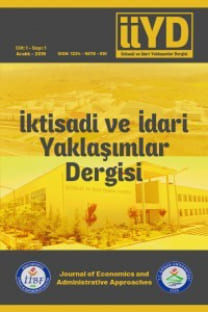DYY ve İşçi Havalelerinin Seçilmiş SAARC Ülkelerinin Ekonomik Büyümesi Üzerindeki Etkileri
İşçi Dövizleri, DYY, Ekonomik büyüme, FMOLS, DOLS
THE EFFECTS OF FDI AND REMITTANCES ON THE ECONOMIC GROWTH OF SELECTED SAARC COUNTRIES
Remittances, FDI, Economic growth, FMOLS, DOLS,
___
- Alfieri, A. Havinga, I. (2006, 2 24). Definition of Remittances. Retrieved 9 21, 2021, from https://unstats.un.org/unsd/tradeserv/tsg3-feb06/tsg0602-14.pdf
- Ayanwale, A. B. (2007). FDI and Economic Growth. Nairobi: The African Economic Research Consortium.
- Bende-Nabende, A., and J.L Ford. (1998). FDI, Policy Adjustment and Endogenous Growth:Multiplier Effects from a Small Dynamic Model for Taiwan 1959–1995. World Development, 26(7), p. 1315–1330.
- Comes, C.-A., Bunduchi, E., Vasile, V., and Stefan, D. (2018). The Impact of Foreign Direct Investments and Remittances on Economic Growth: A Case Study in Central and Eastern Europe. Sustainability, 10(1), p. 238.
- Dahal, P. (2014). The Impact of Remittances on Economic Growth in Nepal: An Analysis of a Significant Basis of Development. Asia Pacific Journal of Public Administration, 36(4), p. 261-282.
- De Gregorio, J. (2003). The Role of Foreign Direct Investment and Natural Resources in Economic Development. Working Paper No 196. Santiago: Central Bank of Chile.
- Eftimoski, D., and Josheski, D. (2020). Reopening The Debate on The Relationship Among Remittances, Household Consumption Stability and Economic Growth in Emerging Markets. International Journal of Emerging Markets, ahead-of-print (ahead-of-print), ahead-of-print .
- Elboiashi, H. A. (2011). The Effect Of FDI and other Foreign Capital Inflows on Growth and Investment in Developing Economies (Phd Theses). Department of Economics, University of Glasgow. Fayissa, B., & Nsiah, C. (2010). The Impact of Remittances on Economic Growth and Development in Africa. The American Economist, 55(2), p. 92–103.
- Ferdaous, J. (2016). Impact of Remittances and FDI on Economic Growth: A Panel Data Analysis. Journal of Business Studies Quarterly, 8(2), p. 8-77.
- Golitsis, P., Avdiu, K., and Szamosi, Leslie T. (2018). Remittances and FDI Effects on Economic Growth: A VECM and GIRFs for the Case of Albania. Journal of East-West Business, 24(3), p. 188-211.
- J, D. J. (2014). Exogenous and Endogenous Growth, University of Pretoria ETD.
- Lopez, H., Molina, L., and Bussolo, M. (2007). Remittances and The Real Exchange Rate. Policy Research Working Paper; No. 4213. Washington DC: World Bank.
- Mahembe, E., and Odhiambo, NM. (2014). Foreign Direct Investment and Economic Growth: A Theoretical Framework. Journal of Governance and Regulation, 3(2).
- Makun, K. (2018). Imports, Remittances, Direct Foreign Investment And Economic Growth in Republic of The Fiji Islands: An Empirical Analysis Using ARDL Approach. Kasetsart Journal of Social Sciences, 39(3), p. 439-447.
- Mansoor, A., and Quillin, B. (2007). Migration and Remittances: Eastern Europe and the Former Soviet Union. Washington DC: World Bank.
- Migration Data. (2021, June 03). Remittances. Retrieved Sep 22, 2021, from Migration Data Portal: https://www.migrationdataportal.org/themes/remittances
- Mint. (2020, Aug 7). A Remittances Crisi Facing South Asia. Retrieved Sep 23, 2021, from Live Mint: https://www.livemint.com/opinion/online-views/a-remittances-crisis-facing-south-asia-11596799996817.html
- OECD. (2002). Foreign Direct Investment for Development Maximizing Benefits Minimizing Costs. Paris: OECD Publications Service.
- OECD. (2020). Foreign Direct Investment. Retrieved 9 21, 2021, from OECD iLiberary: https://www.oecd-ilibrary.org/finance-and-investment/foreign-direct-investment-fdi/indicator-group/english_9a523b18-en
- O'Neill, A. C. (2001). Emigrant Remittances: Policies to Increase Inflows and Maximize Benefits. Indiana Journal of Global Legal Studies, 9(1), p. 345-360.
- Pradhan, Gyan., Upadhyay, Mukti., and Upadhyaya, Kamal. (2008). Remittances And Economic Growth in Developing Countries. The European Journal of Development Research, 20(3), p. 497-506.
- Song, Y., Ummalla, M., Zakari, A., & Kummitha, H.R. (2021). The Effect of Remittances and FDI Inflows on Income Distribution in Developing Economies. Economic Analysis and Policy, 72, p. 255-265.
- Sutradhar, S. (2020). The Impact of Remittances on Economic Growth in Bangladesh, India, Pakistan and Sri Lanka. International Journal of Economic Policy Studies, 14(1), p. 275-295.
- The World Bank Data. (2020). Personal Remittances. Retrieved Sep 22, 2021, from The World Bank Data: https://data.worldbank.org/indicator/BX.TRF.PWKR.CD.DT?end=2020&start=1990
- The World Bank Data. (2021, May 12). Defying Predictions, Remittance Flows Remain Strong During COVID-19 Crisis. Retrieved Sep 22, 2021, from The World Bank Data: https://www.worldbank.org/en/news/press-release/2021/05/12/defying-predictions-remittance-flows-remain-strong-during-covid-19-crisis
- UNCTAD. (2021, June 21). Investment flows to developing Asia defy COVID-19, grow by 4%. Retrieved Sep 23, 2021, from UNCTAD: https://unctad.org/news/investment-flows-developing-asia-defy-covid-19-grow-4
- Yayın Aralığı: Yılda 2 Sayı
- Başlangıç: 2019
- Yayıncı: Şırnak Üniversitesi
DYY ve İşçi Havalelerinin Seçilmiş SAARC Ülkelerinin Ekonomik Büyümesi Üzerindeki Etkileri
MİLLİ MÜCADELE DÖNEMİNDEN CUMHURİYETE KEMALİZMİN AYDINLANMACI VE LAİSİST SÖYLEMİNİN DÖNÜŞÜMÜ
YENİ KAMU İŞLETMECİLİĞİ VE TÜRK EĞİTİM SİSTEMİ: HÜKÜMET PROGRAMLARI ÜZERİNE BİR İNCELEME
SÜRDÜRÜLEBİLİR TÜKETİM EKSENİNDE SÜRDÜRÜLEBİLİR MODA PAZARLAMASI UYGULAMALARI
COVİD-19 GEÇİREN BİREYLERİN DAMGALANMA DENEYİMLERİ
İNSAN-DOĞA İLİŞKİSİ: HACI BEKTAŞ VELİ’NİN MAKALAT’ININ İNCELENMESİ
